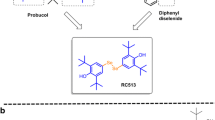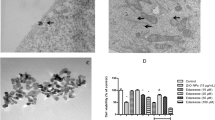Abstract
Chronic exposure to cathinone derivatives increases the risk of severe health hazards, whereas little is known about the detailed pathogenic mechanisms triggered by the derivatives. We have recently shown that treatment with α-pyrrolidinononanophenone (α-PNP, a highly lipophilic cathinone derivative possessing a long hydrocarbon main chain) provokes neuronal cell apoptosis and its 4′-fluorinated analog (F-α-PNP) potently augments the apoptotic effect. In this study, we found that neuronal SK-N-SH cell damage elicited by F-α-PNP treatment is augmented most potently by pre-incubation with an AKR1B1 inhibitor tolrestat, among specific inhibitors of four aldo–keto reductase (AKR) family members (1B1, 1C1, 1C2, and 1C3) expressed in the neuronal cells. In addition, forced overexpression of AKR1B1 remarkably lowered the cell sensitivity to F-α-PNP toxicity, clearly indicating that AKR1B1 protects from neurotoxicity of the derivative. Treatment of SK-N-SH cells with F-α-PNP resulted in a dose-dependent up-regulation of AKR1B1 expression and activation of its transcription factor NF-E2-related factor 2. Metabolic analyses using liquid chromatography/mass spectrometry/mass spectrometry revealed that AKR1B1 is hardly involved in the F-α-PNP metabolism. The F-α-PNP treatment resulted in production of reactive oxygen species and lipid peroxidation byproduct 4-hydroxy-2-nonenal (HNE) in the cells. The enhanced HNE level was reduced by overexpression of AKR1B1, which also lessened the cell damage elicited by HNE. These results suggest that the AKR1B1-mediated neuronal cell protection is due to detoxification of HNE formed by F-α-PNP treatment, but not to metabolism of the derivative.







Similar content being viewed by others
References
Balogh LM, Atkins WM (2011) Interactions of glutathione transferases with 4-hydroxynonenal. Drug Metab Rev 43:165–178. https://doi.org/10.3109/03602532.2011.558092
Barski OA, Tipparaju SM, Bhatnagar A (2008) The aldo-keto reductase superfamily and its role in drug metabolism and detoxification. Drug Metab Rev 40:553–624. https://doi.org/10.1021/bi800301b
Burczynski ME, Lin HK, Penning TM (1999) Isoform-specific induction of a human aldo-keto reductase by polycyclic aromatic hydrocarbons (PAHs), electrophiles, and oxidative stress: implications for the alternative pathway of PAH activation catalyzed by human dihydrodiol dehydrogenase. Cancer Res 59:607–614
Burczynski ME, Sridhar GR, Palackal NT, Penning TM (2001) The reactive oxygen species- and Michael acceptor-inducible human aldo-keto reductase AKR1C1 reduces the alpha, beta-unsaturated aldehyde 4-hydroxy-2-nonenal to 1,4-dihydroxy-2-nonene. J Biol Chem 276:2890–2897. https://doi.org/10.1074/jbc.M006655200
Cao D, Fan ST, Chung SS (1998) Identification and characterization of a novel human aldose reductase-like gene. J Biol Chem 273:11429–11435. https://doi.org/10.1074/jbc.273.19.11429
Chang KC, Petrash JM (2018) Aldo-keto reductases: multifunctional proteins as therapeutic targets in diabetes and inflammatory disease. Adv Exp Med Biol 1032:173–202. https://doi.org/10.1007/978-3-319-98788-0_13
Di Domenico F, Tramutola A, Butterfield DA (2017) Role of 4-hydroxy-2-nonenal (HNE) in the pathogenesis of alzheimer disease and other selected age-related neurodegenerative disorders. Free Radic Biol Med 111:253–261. https://doi.org/10.1016/j.freeradbiomed.2016.10.490
El-Kabbani O, Scammells PJ, Gosling J, Dhagat U, Endo S, Matsunaga T, Soda M, Hara A (2009) Structure-guided design, synthesis, and evaluation of salicylic acid-based inhibitors targeting a selectivity pocket in the active site of human 20 alpha-hydroxysteroid dehydrogenase (AKR1C1). J Med Chem 52:3259–3264. https://doi.org/10.1021/jm9001633
Endo S, Matsunaga T, Ohta C, Soda M, Kanamori A, Kitade Y, Ohno S, Tajima K, El-Kabbani O, Hara A (2011) Roles of rat and human aldo-keto reductases in metabolism of farnesol and geranylgeraniol. Chem Biol Interact 191:261–268. https://doi.org/10.1016/j.cbi.2010.12.017
Eshleman AJ, Wolfrum KM, Reed JF, Kim SO, Swanson T, Johnson RA, Janowsky A (2017) Structure-activity relationships of substituted cathinones, with transporter binding, uptake, and release. J Pharmacol Exp Ther 360:33–47. https://doi.org/10.1124/jpet.116.236349
Esterbauer H, Weger W (1967) Uber die Wirkungen von aldehyden auf gesunde und maligne zellen. 3. Mitt: synthese von homologen 4-hydroxy-2-alkenalen. Monatsh Chem 98:1994–2000
Hazelton GA, Lang CA (1980) Glutathione contents of tissues in the aging mouse. Biochem J 188:25–30. https://doi.org/10.1042/bj1880025
Hicks DR, Kraml M (1984) Determination of tolrestat, a novel aldose reductase inhibitor, in serum and tissues. Ther Drug Monit 6:328–333. https://doi.org/10.1097/00007691-198409000-00013
Iino T, Tabata M, Takikawa S, Sawada H, Shintaku H, Ishikura S, Hara A (2003) Tetrahydrobiopterin is synthesized from 6-pyruvoyl-tetrahydropterin by the human aldo-keto reductase AKR1 family members. Arch Biochem Biophys 416:180–187. https://doi.org/10.1016/s0003-9861(03)00295-9
Jin Y, Stayrook SE, Albert RH, Palackal NT, Penning TM, Lewis M (2001) Crystal structure of human type III 3α-hydroxysteroid dehydrogenase/bile acid binding protein complexed with NADP+ and ursodeoxycholate. Biochemistry 40:10161–10168. https://doi.org/10.1021/bi010919a
Jung KA, Choi BH, Nam CW, Song M, Kim ST, Lee JY, Kwak MK (2013) Identification of aldo-keto reductases as Nrf2-target marker genes in human cells. Toxicol Lett 218:39–49. https://doi.org/10.1016/j.toxlet.2012.12.026
Kaiserova K, Tang XL, Srivastava S, Bhatnagar A (2008) Role of nitric oxide in regulating aldose reductase activation in the ischemic heart. J Biol Chem 283:9101–9112. https://doi.org/10.1074/jbc.M709671200
Kelly JP (2011) Cathinone derivatives: a review of their chemistry, pharmacology and toxicology. Drug Test Anal 3:439–453. https://doi.org/10.1002/dta.313
Leong HS, Philp M, Simone M, Witting PK, Fu S (2020) Synthetic cathinones induce cell death in dopaminergic SH-SY5Y cells via stimulating mitochondrial dysfunction. Int J Mol Sci 21:1370. https://doi.org/10.3390/ijms21041370
Li N, Alam J, Venkatesan MI, Eiguren-Fernandez A, Schmitz D, Di Stefano E, Slaughter N, Killeen E, Wang X, Huang A, Wang M, Miguel AH, Cho A, Sioutas C, Nel AE (2004) Nrf2 is a key transcription factor that regulates antioxidant defense in macrophages and epithelial cells: protecting against the proinflammatory and oxidizing effects of diesel exhaust chemicals. J Immunol 173:3467–3481. https://doi.org/10.4049/jimmunol.173.5.3467
Lin Z, Chen Y, Li J, Xu Z, Wang H, Lin J, Ye X, Zhao Z, Shen Y, Zhang Y, Zheng S, Rao Y (2020) Pharmacokinetics of N-ethylpentylone and its effect on increasing levels of dopamine and serotonin in the nucleus accumbens of conscious rats. Addict Biol 25:e12755. https://doi.org/10.1111/adb.12755
MacLeod AK, McMahon M, Plummer SM, Higgins LG, Penning TM, Igarashi K, Hayes JD (2009) Characterization of the cancer chemopreventive Nrf2-dependent gene battery in human keratinocytes: demonstration that the Keap1-Nrf2 pathway, and not the Bach1-Nrf2 pathway, controls cytoprotection against electrophiles as well as redox-cycling compounds. Carcinogenesis 30:1571–1580. https://doi.org/10.1093/carcin/bgp176
Manier SK, Richter LHJ, Schäper J, Maurer HH, Meyer MR (2018) Different in vitro and in vivo tools for elucidating the human metabolism of α-cathinone-derived drugs of abuse. Drug Test Anal. https://doi.org/10.1002/dta.2355
Matsunaga T, Kotamraju S, Kalivendi SV, Dhanasekaran A, Joseph J, Kalyanaraman B (2004) Ceramide-induced intracellular oxidant formation, iron signaling, and apoptosis in endothelial cells: protective role of endogenous nitric oxide. J Biol Chem 279:28614–28624. https://doi.org/10.1074/jbc.M400977200
Matsunaga T, Shintani S, Hara A (2006) Multiplicity of mammalian reductases for xenobiotic carbonyl compounds. Drug Metab Pharmacokinet 21:1–18. https://doi.org/10.2133/dmpk.21.1
Matsunaga T, Hojo A, Yamane Y, Endo S, El-Kabbani O, Hara A (2013) Pathophysiological roles of aldo-keto reductases (AKR1C1 and AKR1C3) in development of cisplatin resistance in human colon cancers. Chem Biol Interact 202:234–242. https://doi.org/10.1016/j.cbi.2012.09.024
Matsunaga T, Morikawa Y, Kamata K, Shibata A, Miyazono H, Sasajima Y, Suenami K, Sato K, Takekoshi Y, Endo S, El-Kabbani O, Ikari A (2017) α-Pyrrolidinononanophenone provokes apoptosis of neuronal cells through alterations in antioxidant properties. Toxicology 386:93–102. https://doi.org/10.1016/j.tox.2017.05.017
Matsuta S, Shima N, Kakehashi H, Kamata H, Nakano S, Sasaki K, Kamata T, Nishioka H, Miki A, Zaitsu K, Tsuchihashi H, Katagi M (2018) Metabolism of α-PHP and α-PHPP in humans and the effects of alkyl chain lengths on the metabolism of α-pyrrolidinophenone-type designer drugs. Forensic Toxicol 36:486–497. https://doi.org/10.1007/s11419-018-0428-7
Matsuura K, Hara A, Deyashiki Y, Iwasa H, Kume T, Ishikura S, Shiraishi H, Katagiri Y (1998a) Roles of the C-terminal domains of human dihydrodiol dehydrogenase isoforms in the binding of substrates and modulators: probing with chimaeric enzymes. Biochem J 336:429–436. https://doi.org/10.1042/bj3360429
Matsuura K, Shiraishi H, Hara A, Sato K, Deyashiki Y, Ninomiya M, Sakai S (1998b) Identification of a principal mRNA species for human 3α-hydroxysteroid dehydrogenase isoform (AKR1C3) that exhibits high prostaglandin D2 11-ketoreductase activity. J Biochem 124:940–946. https://doi.org/10.1093/oxfordjournals.jbchem.a022211
Mattson MP (2009) Roles of the lipid peroxidation product 4-hydroxynonenal in obesity, the metabolic syndrome, and associated vascular and neurodegenerative disorders. Exp Gerontol 44:625–633. https://doi.org/10.1016/j.exger.2009.07.003
Mohan S, Mohan N, Sprague EA (1997) Differential activation of NF-κB in human aortic endothelial cells conditioned to specific flow environments. Am J Physiol 273:C572–C578. https://doi.org/10.1152/ajpcell.1997.273.2.C572
Morikawa Y, Miyazono H, Sakai Y, Suenami K, Sasajima Y, Sato K, Takekoshi Y, Monguchi Y, Ikari A, Matsunaga T (2021) 4′-Fluoropyrrolidinononanophenone elicits neuronal cell apoptosis through elevating production of reactive oxygen and nitrogen species. Forensic Toxicol 39:123–133. https://doi.org/10.1007/s11419-020-00550-x
Morimitsu Y, Nakagawa Y, Hayashi K, Fujii H, Kumagai T, Nakamura Y, Osawa T, Horio F, Itoh K, Iida K, Yamamoto M, Uchida K (2002) A sulforaphane analogue that potently activates the Nrf2-dependent detoxification pathway. J Biol Chem 277:3456–3463. https://doi.org/10.1074/jbc.M110244200
Negreira N, Erratico C, Kosjek T, van Nuijs AL, Heath E, Neels H, Covaci A (2015) In vitro Phase I and Phase II metabolism of α-pyrrolidinovalerophenone (α-PVP), methylenedioxypyrovalerone (MDPV) and methedrone by human liver microsomes and human liver cytosol. Anal Bioanal Chem 407:5803–5816. https://doi.org/10.1007/s00216-015-8763-6
O’connor T, Ireland LS, Harrison DJ, Hayes JD (1999) Major differences exist in the function and tissue-specific expression of human aflatoxin B1 aldehyde reductase and the principal human aldo-keto reductase AKR1 family members. Biochem J 343:487–504
Penning TM, Burczynski ME, Jez JM, Hung CF, Lin HK, Ma H, Moore M, Palackal N, Ratnam K (2000) Human 3α-hydroxysteroid dehydrogenase isoforms (AKR1C1-AKR1C4) of the aldo-keto reductase superfamily: functional plasticity and tissue distribution reveals roles in the inactivation and formation of male and female sex hormones. Biochem J 351:67–77. https://doi.org/10.1042/0264-6021:3510067
Pinterova-Leca N, Horsley RR, Danda H, Žídková M, Lhotková E, Šíchová K, Štefková K, Balíková M, Kuchař M, Páleníček T (2021) Naphyrone (naphthylpyrovalerone): pharmacokinetics, behavioural effects and thermoregulation in Wistar rats. Addict Biol 26:e12906. https://doi.org/10.1111/adb.12906
Shiraishi H, Ishikura S, Matsuura K, Deyashiki Y, Ninomiya M, Sakai S, Hara A (1998) Sequence of the cDNA of a human dihydrodiol dehydrogenase isoform (AKR1C2) and tissue distribution of its mRNA. Biochem J 334:399–405. https://doi.org/10.1042/bj3340399
Srivastava SK, Yadav UC, Reddy AB, Saxena A, Tammali R, Shoeb M, Ansari NH, Bhatnagar A, Petrash MJ, Srivastava S, Ramana KV (2011) Aldose reductase inhibition suppresses oxidative stress-induced inflammatory disorders. Chem Biol Interact 191:330–338. https://doi.org/10.1016/j.cbi.2011.02.023
Swortwood MJ, Ellefsen KN, Wohlfarth A, Diao X, Concheiro-Guisan M, Kronstrand R, Huestis MA (2016) First metabolic profile of PV8, a novel synthetic cathinone, in human hepatocytes and urine by high-resolution mass spectrometry. Anal Bioanal Chem 408:4845–4856. https://doi.org/10.1007/s00216-016-9599-4
Thanislass J, Raveendran M, Devaraj H (1995) Buthionine sulfoximine-induced glutathione depletion. Its effect on antioxidants, lipid peroxidation and calcium homeostasis in the lung. Biochem Pharmacol 50:229–234. https://doi.org/10.1016/0006-2952(95)00123-h
Usui S, Matsunaga T, Ukai S, Kiho T (1997) Growth suppressing activity for endothelial cells induced from macrophages by carboxymethylated curdlan. Biosci Biotechnol Biochem 61:1924–1925. https://doi.org/10.1271/bbb.61.1924
Vander Jagt DL, Kolb NS, Vander Jagt TJ, Chino J, Martinez FJ, Hunsaker LA, Royer RE (1995) Substrate specificity of human aldose reductase: identification of 4-hydroxynonenal as an endogenous substrate. Biochim Biophys Acta 1249:117–126. https://doi.org/10.1016/0167-4838(95)00021-l
Wojcieszak J, Andrzejczak D, Wojtas A, Gołembiowska K, Zawilska JB (2018) Effects of the new generation α-pyrrolidinophenones on spontaneous locomotor activities in mice, and on extracellular dopamine and serotonin levels in the mouse striatum. Forensic Toxicol 36:334–350. https://doi.org/10.1007/s11419-018-0409-x
Zawilska JB, Wojcieszak J (2013) Designer cathinones-an emerging class of novel recreational drugs. Forensic Sci Int 231:42–53. https://doi.org/10.1016/j.forsciint.2013.04.015
Acknowledgements
We are indebted to Dr. Akira Hara for his insightful comments.
Author information
Authors and Affiliations
Corresponding author
Ethics declarations
Conflict of Interest
The authors declare no competing interests.
Additional information
Publisher's Note
Springer Nature remains neutral with regard to jurisdictional claims in published maps and institutional affiliations.
Supplementary Information
Below is the link to the electronic supplementary material.
Rights and permissions
About this article
Cite this article
Morikawa, Y., Miyazono, H., Kamase, K. et al. Protective Effect of Aldo–keto Reductase 1B1 Against Neuronal Cell Damage Elicited by 4′-Fluoro-α-pyrrolidinononanophenone. Neurotox Res 39, 1360–1371 (2021). https://doi.org/10.1007/s12640-021-00380-8
Received:
Revised:
Accepted:
Published:
Issue Date:
DOI: https://doi.org/10.1007/s12640-021-00380-8




